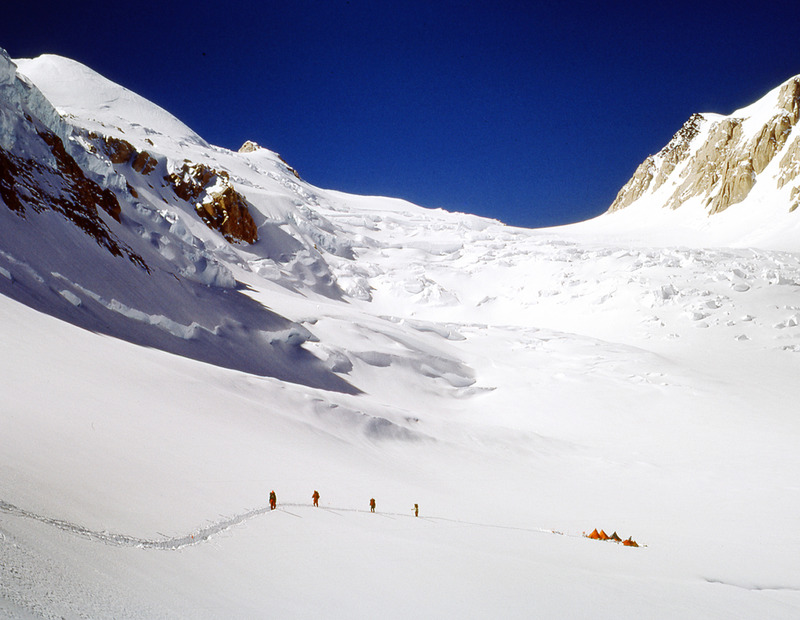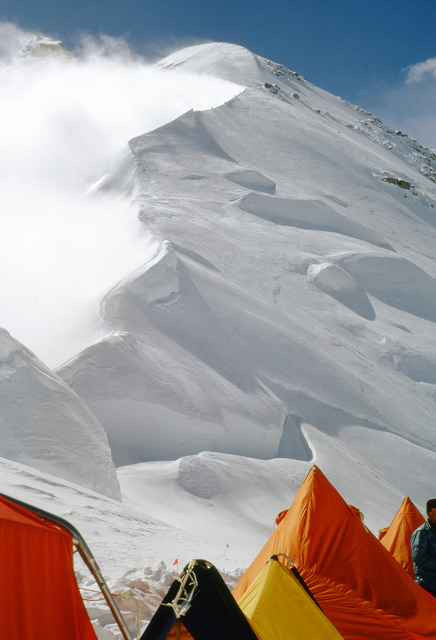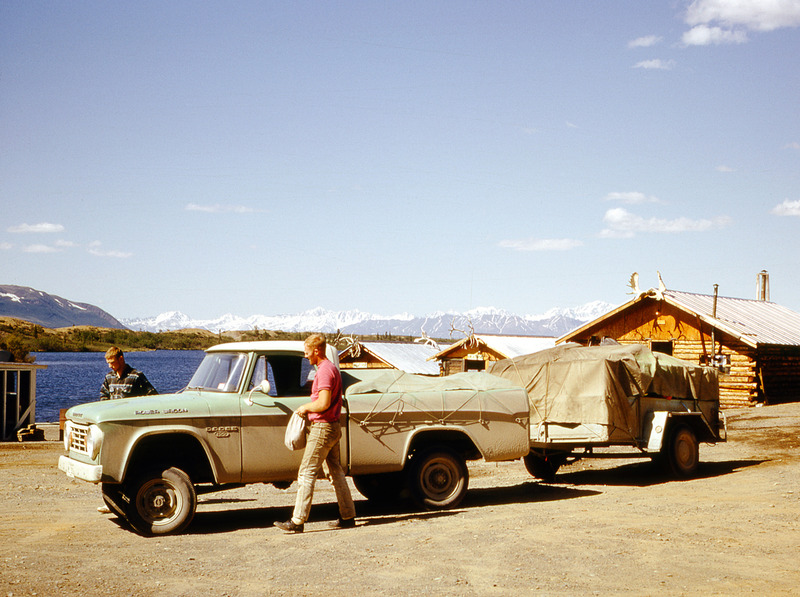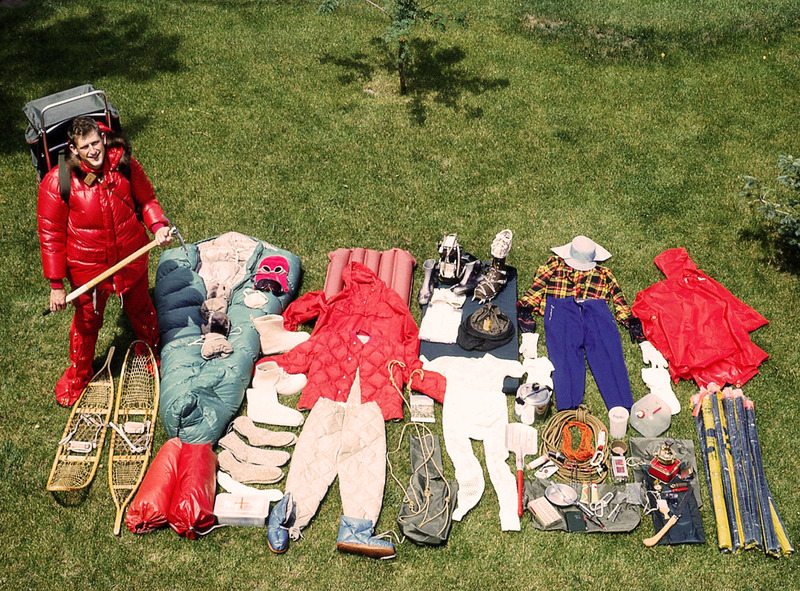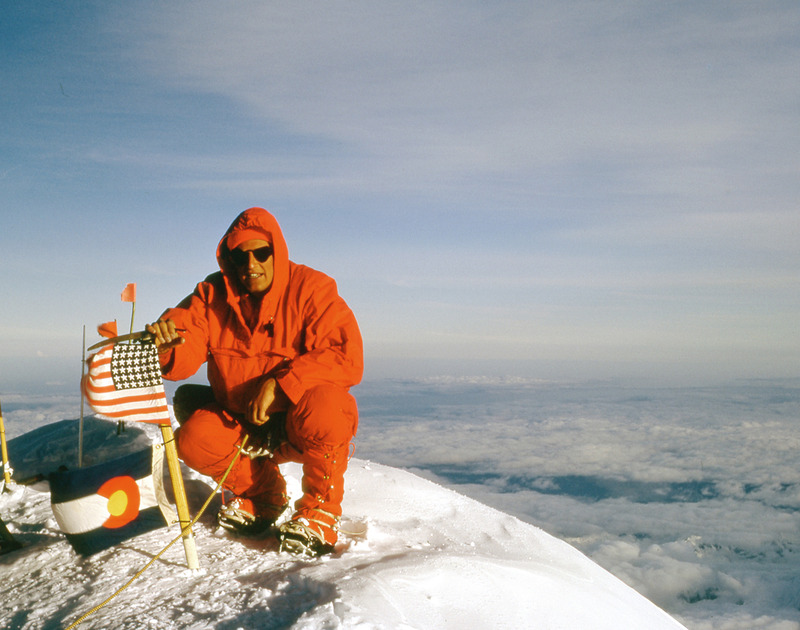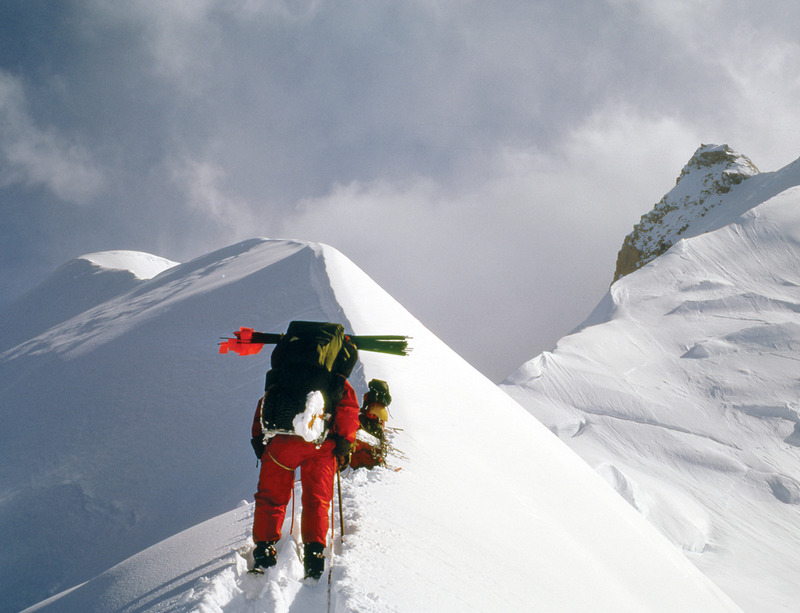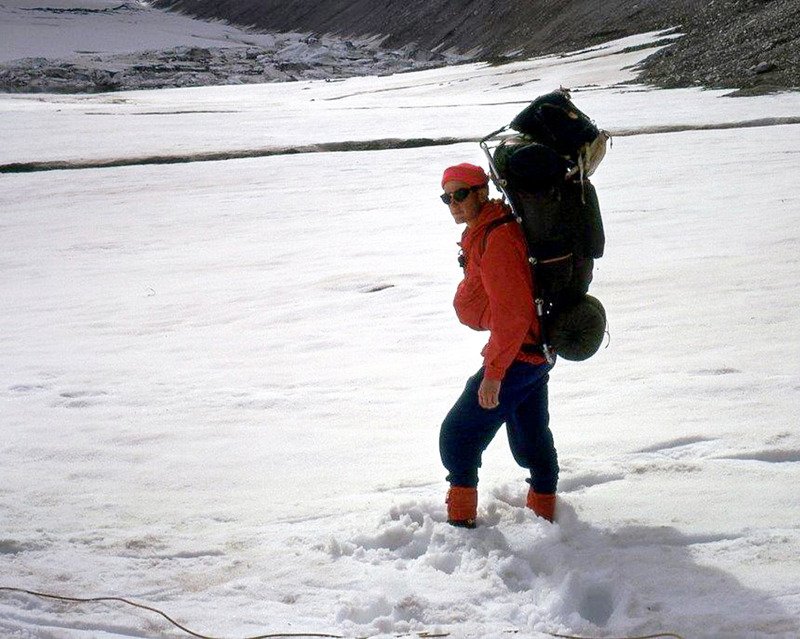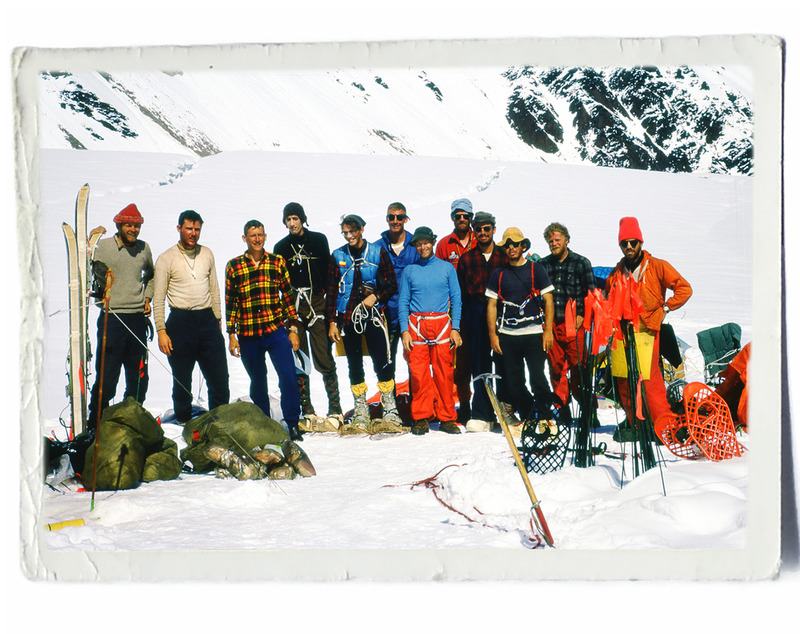The Local newsletter is your free, daily guide to life in Colorado. For locals, by locals.
Twenty-seven days after leaving the boggy lowlands of Denali National Park and Preserve in Alaska, Paul Schlichter and Howard Snyder stood atop 20,320-foot Denali, the highest peak in North America. It was July 15, 1967, and the 22-year-old climbers slapped each other’s backs and admired the wide-open views. “You could see forever—not too windy, not too cold,” says Schlichter, now 72 and originally from Lakewood. It was sunny and about six degrees Fahrenheit, warm for the mountain, which is among the coldest places on Earth. The 17,400-foot Mt. Foraker was visible in the distance. “You couldn’t order it better than we had it on that day,” says Snyder, also 72, who grew up in Boulder and today lives in Canada.
Schlichter and Snyder were part of a team called the Wilcox expedition, a 12-man group of loosely affiliated climbers from around the country who’d come together at the last minute. Ranging in age from 22 to 31 and led by Joe Wilcox, a 24-year-old graduate student at Brigham Young University, they hoped to climb Denali via the Muldrow Glacier on the north side of the mountain, a line that’s more remote—and less expensive to access—than the West Buttress option, which is the most common way up the peak.
Initially, Schlichter and Snyder planned to climb Denali with their own Colorado group, which consisted of the pair and two other men: Jerry Lewis, a 30-year-old Army vet and college student from Boulder, and his younger brother Steve. But Steve broke his nose and hand in a car accident seven hours before the team was set to leave for Alaska. The group was thus reduced to three, one man short of the minimum requirement, and the National Park Service suggested the Colorado contingent—Snyder, Schlichter, and Lewis—join forces with the nine-man Wilcox expedition.
An hour and a half after reaching the summit, Snyder, Schlichter, Lewis, and Wilcox began their descent. They worked their way down the summit ridge, which plunges 8,500 feet on one side to the Kahiltna Glacier below; trudged past Archdeacons Tower, a small subpeak at 19,393 feet; and continued on to Denali Pass about a thousand feet lower, where the wind began to pick up. Meanwhile, eight other climbers from their party were preparing for their own summit bid after a day of rest at lower elevations. Above them, wispy cirrus clouds painted the sky—mares’ tails, the unsettling signature of an approaching storm.
Known as the “Great One” by the area’s indigenous Athabaskan people, De-nali dominates the landscape of Southcentral Alaska, rising 18,000 feet from the surrounding plateau, which sits 2,000 feet above sea level. As a result of this dramatic vertical relief, Denali offers one of the longest base-to-summit climbs on the planet, one that’s about 6,000 feet greater than that of Mt. Everest, where climbers start at 17,000 feet and top out at 29,029 feet.

Since it was first summited in 1913, Denali—which was officially renamed from McKinley to its indigenous moniker in 2015—has seen 22,608 people reach its summit (as of press time). When the Wilcox expedition made its attempt in 1967, however, only 213 people had ever scaled it. With an average summit success rate of about 50 percent, Denali’s challenge lies not so much in its technical difficulty but rather in its highly unpredictable conditions. “It’s the toughest mountain on Earth because of the weather,” says Chris Tomer, a Denver-based meteorologist who has forecasted for teams on Denali for the past 10 years.
Denali is roughly located at the 63rd parallel north, compared to Everest, which sits at about 28 degrees north latitude, almost the same as Florida’s Walt Disney World. Storm systems are stronger and move faster at higher latitudes, and air temperatures are colder. Whereas Everest lies in the middle of the Asian continent, more than 1,000 miles from the nearest major body of water, Denali is situated about 200 miles from the Gulf of Alaska and some 400 miles from the Bering Sea. As such, the mountain is subject to intense low-pressure systems that are stronger than those in almost any other place on the planet. These systems give birth to storms that can emerge out of nowhere and have the potential to be powerful and extremely cold—and to roll in one after another over the course of a week or longer.
On top of all of that, Denali’s immense topographic relief enhances snow totals dramatically. “Air is lifted as wind slams into Denali, and rising air at those altitudes develops into clouds and snow. A typical six-inch snowfall turns into a foot quickly,” Tomer says. “Denali,” he adds, “is in the perfect position for perfect storms.”
About two hours after leaving the summit, Schlichter, Snyder, Wilcox, and Lewis arrived at their camp at 17,900 feet, where they found their eight teammates preparing for their summit bid. That team planned to depart the next day, July 16.
It was no surprise Schlichter and Snyder had made it to the summit with the first team—they were two of the most experienced and fit climbers on the Wilcox expedition. After meeting in 1963 in a summer civics leadership course, they’d spent four years honing their mountaineering skills—and forging their friendship—on Colorado’s fourteeners, Washington’s 14,410-foot Mt. Rainier, and 18,491-foot Pico de Orizaba in Mexico.
Schlichter had graduated from the U.S. Air Force Academy in Colorado Springs in June and was preparing for pilot training at the end of the summer. He was reserved and possessed a quiet fortitude that lent itself to mountaineering and to the military. The more gregarious of the two, Snyder was working toward his geography degree from the University of Colorado Boulder. He was charismatic and engaging and had been the leader of the Colorado team before his squad was folded into the Wilcox expedition.
The other climbers on the team had varying degrees of experience and physical conditioning. Everyone struggled with Denali’s high elevations; however, aside from Schlichter and Snyder, none had ever been above 15,000 feet.
After waiting out adverse weather—including 70 mph winds and blowing snow—the Wilcox expedition woke to cloudy, breezy weather on the 17th, but the skies cleared as the morning progressed. By 1 p.m., it was sunny and near cloudless, and the four men who had already summited prepared to head down to camp at 15,000 feet, expecting that the others would start for the summit 10 to 15 minutes after their departure. Anshel Schiff, a 30-year-old assistant college professor from Indiana, had been battling altitude sickness. At the last minute, he decided to forgo the summit and head down the mountain with Snyder and Schlichter’s group.
As Snyder, Schlichter, Lewis, Wilcox, and Schiff hiked down to the lower camp, they had a clear view of the 17,900-foot camp above them. They were surprised to see that the second group had not yet left for the top. Instead, the mountaineers were milling about camp—packing, tidying up, and searching for fuel bottles that had been stashed and gear that had been buried by the previous day’s storm. “You don’t waste good weather on Denali,” Schlichter says. “When the weather is good, you go.”
Led by Jerry Clark, a 31-year-old electrical engineer from Eugene, Oregon, who’d been on expeditions to Antarctica, the second team finally left for the summit around 3 p.m. Suffering from altitude sickness, recent college graduate Steve Taylor, 23, opted to stay behind at the high camp, which meant that six men were now heading for the top.
About five hours later, at 8:30 p.m., Clark radioed the rangers at Eielson Visitor Center and reported that they were high up on the mountain and unsure of where they were. An intense fog had closed in, making it impossible for the team to see the route to the top. The team hunkered down for the night, hoping the weather would clear. Because they had been planning to move quickly up and down the mountain, they had little food, few sleeping bags, and no tents.
At 11:30 a.m. on July 18, Clark again radioed the rangers at Eielson Visitor Center, relaying the news that his team had made it to the summit. Clark reported that it was seven degrees, the wind was blowing, they were experiencing white-out conditions, and they planned to head down within five to 10 minutes. The team also reported that only five men—Dennis Luchterhand, Henry Janes, Mark McLaughlin, Walt Taylor, and Clark—had made it to the top. The sixth man, John Russell, was not accounted for. They closed out the conversation from the summit by saying the team would radio again at 8 that night. That call never came.
After the team signed off from the summit on July 18, one of the worst storms in Denali’s history descended on the mountain. According to National Weather Service models, gusts high on the peak increased to 100 mph and eventually reached 300 mph. Temperatures plunged to 15 to 30 degrees below zero.
By the time Snyder and Schlichter’s group of five reached base camp on July 25, the other seven members of the expedition were likely dead. Denali would be the final resting place for Luchterhand, Janes, Walt Taylor, Steve Taylor, Russell, McLaughlin, and Clark.
Only three bodies were ever found. Ravaged by the elements, no one knows definitively whose remains they were or what exactly transpired high on the peak during the storm, but Snyder and Schlichter have theories—namely that after the call from the summit, the men were hit by the monster tempest. “These guys were still either on the very summit itself or on the summit ridge above 20,000 feet when that storm hit,” Snyder says. “All of a sudden, the air turns opaque. You can’t see anything, and the wind starts immediately. You can’t imagine a worse situation.” In weather like that, backpacks blow away and the wind rips gloves off hands. Trying to navigate down the peak in those conditions would have been impossible. Schlichter adds, “I think they started down and they reached a point where they said, ‘It’s every man for himself.’ ”
Two of the bodies were found on the slopes of Archdeacons Tower. “I think those two bodies were probably Walt Taylor and Denny Luchterhand,” Schlichter says. “Those two guys were in pretty good shape—pretty healthy and pretty strong.” Snyder believes they tried to make a beeline directly from Archdeacons Tower down a steep, 4,000-foot slope to the camp at 15,000 feet and perished along the way.
Another body was found at the high camp; Snyder believes it was Russell. He suspects that at some point during the summit bid, weakened by the elevation, Russell turned around and headed back to the high camp, where he was eventually overcome by the storm. Steve Taylor’s ice ax and sleeping bag were found at the lip of the Harper Icefall, between the high camp and the 15,000-foot camp, close to a crevasse that had a hole in its snow bridge. “The speculation was that he had gotten that far, set up his ax, and draped his sleeping bag around it as a signal to us down at 15,000 feet,” Snyder says. “Then, either trying to return to high camp or trying to press on toward us, he had fallen into the crevasse.” As for the other men, it’s likely no one will ever know what befell them.
For years after the incident, there was much debate about who, or what, was to blame. People were critical of the National Park Service because they believed, mistakenly, that it had forced the two expeditions to climb together, which meant that the teams’ dynamics were likely compromised. Others, namely the parents of the deceased, believed the National Park Service should have launched a rescue effort sooner.
Leader Joe Wilcox came under heavy scrutiny. He was condemned for being unqualified to head up the expedition, having poor leadership skills, and summiting with the Colorado contingent instead of waiting to climb with members from his original team. Others believed that if he had exercised stronger leadership and forced Steve Taylor and Russell to descend to a lower elevation because of their compromised states, the tragedy’s outcome would have been different.
Wilcox, too, blamed himself. It wasn’t until three studies came out—two by the National Weather Service and one by the National Oceanic and Atmospheric Administration—demonstrating that the storm was unsurvivable that he was able to absolve himself and move on. “We couldn’t have done anything for the climbers up there,” says Wilcox, who teaches astronomy at the University of Hawaii and splits his time between Hawaii and Washington state. “It’s certainly taken me a long time and the advent of lots of studies to realize that. Even though I knew these people and felt that they could have and should have survived, I now have to accept that they, and probably anybody else, couldn’t have survived up there.”
Over time, Snyder and Schlichter have come to similar conclusions about what happened on the mountain. “The tragedy was caused by those guys not taking advantage of the good weather, first on our summit day, then on their summit day,” Snyder says. “And, mainly, the weather. It doesn’t matter how strong, how experienced, or how cautious you are—if you get caught in the circumstances they were, that’s going to be the result.” Schlichter also believes that the outcome was probably inevitable: “Nothing anybody could have done would have made a difference.”
The 1967 episode remains the deadliest climbing disaster in Denali’s history, but 50 years after the expedition, Schlichter and Snyder have come to terms with the episode. By the end of 1968, Schlichter was in Vietnam, and the trauma of war soon overshadowed what had happened on Denali. After his service, he went on to have a successful career in banking and security. He’s now semi-retired and lives in Castle Rock. Snyder resides near Cardston, Alberta, where he’s the director of the Remington Carriage Museum, which houses the largest collection of horse-drawn carriages in North America.
Although the tragedy on Denali shaped both men’s lives, it did not diminish their affinity for nature, and they continued to explore wild places in Colorado and beyond. “Denali reinforced my love of the wilderness and the beauty you can see in the wilderness,” Snyder says. “Sometimes things go terribly wrong and the maximum price is exacted, as it was on Denali, but there’s so much beauty in the mountains. It makes the hair on the back of my neck stand up.”



